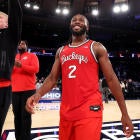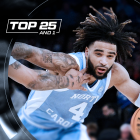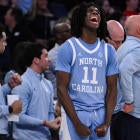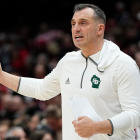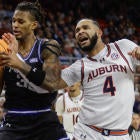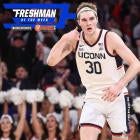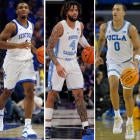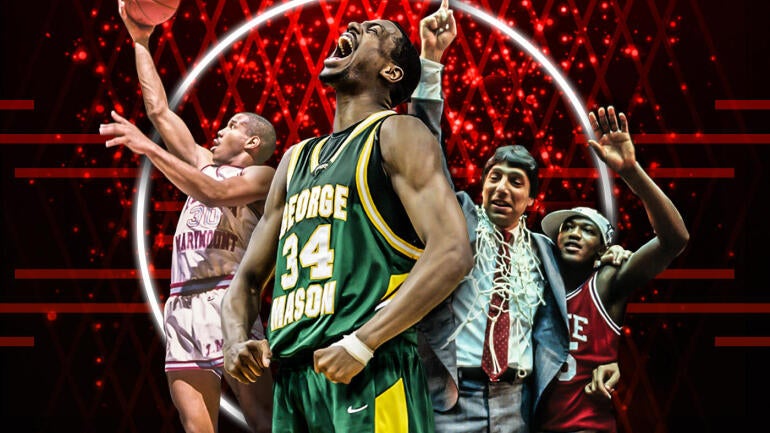
The 2022 NCAA Tournament has included the same kind of upsets we're used to seeing in March Madness, but there was one Cinderella story that's taken on a historic status with No. 15 seed Saint Peter's reaching the Elite Eight. Shaheen Holloway's Peacocks were just the 10th No. 15 seed to knock off a No. 2 seed in the first round, the third No. 15 seed to make the Sweet Sixteen, and after defeating Purdue on Friday night, have become the first-ever No. 15 to reach the Elite Eight.
That run came to an end on Sunday with a 69-49 loss to No. 8 seed North Carolina, but no one will forget the Peacocks' strut through March Madness in 2022. It's undoubtedly carved out a spot on the list of the greatest Cinderella stories in NCAA Tournament history.
So who else is on that list, and where do the Peacocks rank at this point in their journey? Ranking "best Cinderella stories in tournament history" is an inexact science, but we've tried to lean on the combination of seed and finish to provide some objective analysis. Still, intangible aspects like the impact of the run on college basketball or sports fans in general were absolutely taken into consideration. The term "Cinderella team" draws its name from a fairy tale after all, so leaning too much on science would be a disservice to these magical moments in tournament history.
Here are the 25 best NCAA Tournament Cinderella runs.
25. Richmond 1988 -- No. 13 to Sweet 16
Spot 25 is dedicated to Dick Tarrant, a well-respected tactician and the face behind one of the most revered mid-majors of the 1980s and early 1990s. In 1984, the program's first-ever NCAA Tournament appearance, the Spiders knocked off Charles Barkley and Auburn in the first round. In 1988 they did the same against defending champion Indiana, and went on to beat a Bobby Cremins-coached Georgia Tech team in the second round to make the Sweet 16 for the first time in program history. The slipper would fit again for Richmond in 1991, leading wire-to-wire against Syracuse in the first 15-2 upset.
24. Chattanooga 1997 -- No. 14 to Sweet 16
Chattanooga's run is a who's who of college hoops. The Mocs pulled off the unlikely first round upset against a Tubby Smith-coached Georgia team and followed that up with a second victory against a Lon Kruger-coached Illinois squad. The 1997 tournament was a strange one in that the Mocs were actually one of three double-digit seeds to advance in their own region and eventually fell to a Pete Gillen-coached Providence team, the 10-seed, which had beaten Duke the week before in the second round.
23. Valparaiso 1998 -- No. 13 to Sweet 16
Homer Drew was the head coach, Scott Drew was an assistant on the bench and Bryce Drew got the ball on the play that put Valpo on the map in college basketball. The play, called "Pacer," maybe never gets a chance to happen if 74% free-throw shooter Ansu Sesay doesn't miss at the charity stripe, but the current Baylor coach, the former Vanderbilt coach and their father are sure glad things shook out the way they did.
The play required a perfect full-court pass and a one-touch dump off to Drew for the coach's son to bury the three-pointer at the buzzer. All in 2.5 seconds.
22. South Carolina 2017 -- No. 7 to Final Four
In the early 1970s, Frank McGuire had South Carolina rolling with four straight NCAA Tournament appearances, but after he stepped down in 1980 the program saw just one tournament bid in the next decade and only four in the following 35 years. The days when Gamecocks basketball ruled the southeast appeared long gone, until No. 2 Duke stepped onto the floor for a second-round game in Bon Secours Wellness Arena in Greenville, S.C.
Very quickly, Sindarious Thornwell and P.J. Dozier became household names as the No. 7 seed from the SEC rode what became a rowdy home-court edge during a 65-point second half to a 88-81 win against the Blue Devils. Madison Square Garden was expecting to get Villanova and Duke in the Elite Eight but ended up with a thriller between SEC rivals South Carolina and Florida. Frank Martin elevated himself and the South Carolina program to levels where Frank McGuire never reached, making it to the Final Four for the first time in program history.
21. Bradley 2006 -- No. 13 to Sweet 16
It's odd looking back more than a decade later to see that the Missouri Valley Conference had as many NCAA bids (4) as the ACC and Big 12 in 2006. The Braves won seven of their final eight games to earn an at-large spot in the field of 68 and then carried that success into the the tournament and reached the Sweet 16 for the first time since 1955.
20. Kent State 2002 -- No. 10 to Elite Eight
Ken State beat No. 7 seed Oklahoma State and No. 2 seed Alabama to get to the Sweet 16, then beat 3-seed Pitt -- Kent State never trailed against OSU and also went wire-to-wire in its second-round win over Bama to advance to the Sweet 16 for the first time ever. They then extended their winning streak (21) into the Elite Eight. Stan Heath, a rookie coach at the time at the age of 36, was fresh from Tom Izzo's staff at Michigan State and had four seniors to lead the way for the one of the most memorable seasons in program history.
19. Dayton 2014 -- No. 11 to Elite Eight
Dayton was 13-8 at the end of January, but in a watershed year for the Atlantic 10 the Flyers were able to capture an at-large bid in the NCAA Tournament and beat Ohio State, Syracuse and Stanford before losing to Florida in the Elite Eight. Jordan Sibert was the star then, but Archie Miller has become the face of that run now, even just three short years later. He's gotten the Flyers to the NCAA Tournament each of the last two years, and gone 29-6 in Atlantic 10 play while claiming at least a share of the last two regular-season titles. He's a rising star in the coaching profession and the top name buzzing on the lips of fans looking for a head coach this offseason.
18. Florida Gulf Coast 2013 -- No. 15 to Sweet 16
The birth of Dunk City. Florida Gulf Coast is the example of when exceptionally skilled offensive talent responds better to the big stage than its opposition. What makes Dunk City highest-rated of the No. 15 seeds to make a second-weekend run was the flare with which they bounced Georgetown and San Diego State from the tournament.
17. Cleveland State 1986 -- No. 14 to Sweet 16
Ken "Mouse" McFadden led the "run 'n' stun" attack and full-court pressure defense that beat Bobby Knight's Indiana team in the first round and later came within one point of knocking off David Robinson's Navy team in the Sweet 16. In 2009, when Cleveland State was set to make its first NCAA Tournament appearance since the run, head coach Kevin Mackey told the Cleveland Plain-Dealer that they used to work on full-court pressure and traps with the Vikings for an hour and a half each day. That 2009 Cleveland State team, by the way, went on to beat Wake Forest in the first round in 2009.
16. Oral Roberts 2021 — No. 15 to Sweet 16
The college basketball world quickly became infatuated with the high-scoring duo of Max Abmas and Kevin Obanor, as the guard-forward combo led the Golden Eagles to a first round upset of No. 2 seed Ohio State, a second round win against No. 7 seed Florida and then took No. 3 seed Arkansas the distance before coming up just short in a 72-70 loss in the Sweet 16. For Oral Roberts the excitement came not just from seeing a smaller Summit League team take down the power conference opponents but the thrilling nature of the results. All three games in Oral Roberts' run were decided by three points or less and ranked among the most exciting contests of the whole 2021 tournament.
15. Providence 1987 -- No. 6 to Final Four
A pair of basketball greats were just emerging into the consciousness for the Friars' 1987 run. Second-year coach Rick Pitino relied heavily on point guard Billy Donovan, who dropped 35 points in the first round, 35 points in the second round and 26 in an upset of 2-seed Alabama in the Sweet 16. Up next was Big East rival Georgetown in a rubber match after a 1-1 split in the season series. Donovan -- then "Billy the Kid" to some -- had 20 points against the Hoyas to propel the Friars into the Final Four.
14. Wisconsin 2000 -- No. 8 to Final Four
We're used to Wisconsin dominating now, but two decades ago their place in the big dance was more novelty than expectation. Dick Bennett, father of current Virginia coach Tony Bennett, was the first coach in school history to take the Badgers to three NCAA Tournaments and the first coach since 1941 to reach the Final Four. The calling card was of course the defense, as this 19-13 team from the regular season beat No. 1 seed Arizona, LSU, and Purdue while holding all its opponents to 60 points or less on the march to the Final Four. Eventually Wisconsin lost to Michigan State, who would go on to win the national championship that year.
13. Wichita State 2013 -- No. 9 to Final Four
It was the year that "play angry" became a thing, and so did Gregg Marshall. Ron Baker and Fred VanVleet were young freshmen and budding college basketball stars while Cleanthony Early led Wichita State in scoring and rebounding. The Shockers beat 1-seed Gonzaga and 2-seed Ohio State on this run before falling to Louisville, the eventual champion, in the Final Four. This was the beginning of Marshall's moment with Wichita State, a moment that will continue with their highly anticipated showing in the 2017 NCAA Tournament.
12. Davidson 2008 -- No. 10 to Elite Eight
Just a lanky sophomore at the time, Stephen Curry stole the hearts of basketball fans everywhere with his clutch performances in Davidson's ridiculous Cinderella run in 2008. The Wildcats got to start their run just a few hours down the road in Raleigh, N.C., where the arena of mixed fan bases all ended up rooting for the sharp-shooting son of Dell Curry by the end of their two games in the pod. The games were close, everyone knew Curry was going to get the ball and still he delivered with 40 points in a six-point win against Gonzaga and 30 points in a four-point win against 2-seed Georgetown. In the Sweet 16, the future MVP dropped 33 against Wisconsin and then finally cooled off in a two-point loss to Kansas, the eventual national champion, in the Elite Eight.
11. Gonzaga 1999 -- No. 10 to Elite Eight
This was the start of it all for Mark Few, the first run that made Gonzaga a regular contributor to the college basketball scene. Now the Zags are battling for top seeds on an annual basis and no longer considered a Cinderella. The Zags beat No. 2 Stanford in the second round, then beat Florida in the Sweet 16 on a basket with four seconds left before falling to Rip Hamilton's UConn Huskies in the Elite Eight.
10. George Mason 2006 -- No. 11 to Final Four
A Cinderella run doesn't require that the team come from a mid-major conference, but if that was a qualification then the conversation has to always start with George Mason. In 2006, Jim Larranaga led the Patriots to the Final Four as the first mid-major team to get that far since 1979. Jai Lewis and Will Thomas crashed the glass while the team shared the scoring responsibility and squeezed the life out of opponents on defense. George Mason beat Michigan State, North Carolina, Wichita State (then coached by Mark Turgeon, now at Maryland) and finally outplayed and outlasted a Jim Calhoun-coached UConn team in an overtime thriller in the Elite Eight.
9. LSU 1986 -- No. 11 to Final Four
LSU was the first 11-seed to make the Final Four, the lowest seed ever, and did so after barely making the tournament. The Tigers won just eight of their last 19 games but still got a home-court advantage in the draw that brought an expected amount of grumbling from the opposition. LSU beat Purdue in double overtime, took down Memphis on an Anthony Wilson buzzer beater and finally beat Kentucky after three losses to the Wildcats earlier in the year. Dale Brown's defense played a huge role in the unexpected tournament wins in what is still a banner year for the LSU program.
8. Loyola-Chicago 2018 — No. 11 to Final Four
The run that introduced Sister Jean to the college basketball and sports world in general put Loyola-Chicago, a proud program with a national championship to its name (1963) that took over the 2018 NCAA Tournament by emerging form the chaos-filled South Region. The road to the Final Four was benefited by not only No. 1 seed Virginia getting bounced by No. 16 seed UMBC in the first round, but by No. 8 seed Kansas State taking down the presumed new regional favorite Kentucky in the Sweet 16. But Loyola's ranking, and the reason why so many loved the story, was rooted not just in Sister Jean or the their seed line but the thrilling endings to each and every game. Wins against No. 6 seed Miami, No. 3 seed Tennessee and No. 7 seed Nevada were by a combined four points, so when Loyola was up double-digits late in a 16-point win against Kansas State in the Elite Eight there was a well-deserved coronation moment in Atlanta for this epic Cinderella run.
7. Kansas 1988 -- No. 6 to NCAA Tournament champion
Oklahoma had 35 wins going into the 1988 national championship game, two of them against Big Eight rival Kansas. But the Jayhawks had the best player in college basketball that year, Danny Manning, and a willing but beat-up roster that history now simply refers to as the "Miracles." Instead of being intimidated by Oklahoma's defensive pressure, Larry Brown decided to play at their pace and take his chances with Manning (who finished with 31 points, 18 rebounds, two blocks and five steals) leading the way. Kansas had dealt with injuries, suspensions and disappointments through the year but finished on top with its first national title since Phog Allen was the head coach in Lawrence.
6. VCU 2011 -- No. 11 to Final Four
VCU entered the 2011 NCAA Tournament in the First Four, in the first year of the first four, and finished in the Final Four. The Rams' Jamie Skeen was one of four senior starters for this group that put Shaka Smart, then 33, square in the college basketball spotlight. They had Lil B on their side ("swag") and plenty of good mojo during the improbable extra-game run that started with a fourth place finish in the CAA and ended with a loss to Butler in the Final Four. Along the way VCU beat USC, Georgetown, Purdue, Florida State and Kansas while laying the foundation for both Smart and the VCU program to remain relevant to this day.
5. Butler 2011 -- No. 8 to title game
We had to choose one, so it's Butler's second run, not the first (in 2010, losing to Duke on Gordon Hayward's close miss at the buzzer from half court), that gets the nod for our Cinderella rankings. Having seen Brad Stevens and Matt Howard win the hearts of fans looking for an underdog the year before brought buzz to their run the second it even seemed likely, even if Gordon Hayward was off to the NBA.
That meant that everyone was watching as Butler advanced in the most bizarre way. First came Matt Howard's tip-in at the buzzer against Old Dominion then his last-second free throw to beat Pitt, the No. 1 seed in the Southeast. The Bulldogs went on to beat Wisconsin and advance to the Final Four with an overtime win against Florida. The Final Four experience wasn't as poetic this time, ending in a clunky loss to UConn, but the run was more memorable for its bizarre twists and turns. For many, the sequel was better than the original.
4. Villanova 1985 -- No. 8 to NCAA Tournament champion
The Wildcats are still the lowest seed to win a national title, doing so in the first year of the 64-team bracket. Far from a mid-major, Villanova won the NCAA Tournament in a year that a Big East dominated the college basketball landscape and put three teams in the Final Four, they just weren't the Big East team that anyone expected to win it all.
Georgetown was the defending champion and had Patrick Ewing, but before another rematch with the Hoyas Ed Pinckney and Villanova had to get through 1-seed Michigan, Len Bias and Maryland and a Dean Smith-coached North Carolina team that had just lost Michael Jordan but still had Brad Daugherty as its star. After beating Memphis in the Final Four, a lovable bunch of underdogs took the court on the game's biggest stage against the game's biggest player and played out of their minds in a 66-64 win.
Rollie Massimino has laughed off the idea that Villanova played a "perfect" game against Georgetown in the national championship game despite shooting 78.6 percent from the field, making sure to note the Wildcats had 17 turnovers in the contest as well.
3. Saint Peter's 2022 — No. 15 to Elite Eight
Simply being the the first No. 15 seed to reach the Elite Eight jumps the Peacocks to the front of the line, but putting this run under a microscope only strengthens the argument for one of the best Cinderella stories in tournament history. Saint Peter's didn't just make it to the Elite Eight from the No. 15 seed line, it did so taking the most difficult path possible by beating a No. 2 seed, a No. 7 seed and a No. 3 seed to reach the regional final. But even beyond the seed numbers is the quality of opponents, with Kentucky, Purdue and Murray State all having at least 26 wins and being among the best (or in the Racers' case, the best) teams in their respective conferences. For two weeks, the entire sports world has been fascinated with this small MAAC program at a school with an enrollment of less than 2,200 undergraduates. It's the modern poster child for a Cinderella story in the NCAA Tournament, and a big reason why this event is one of the greatest postseasons in all of American sports.
2. Loyola Marymount 1990 -- No. 11 to Elite Eight
Loyola Marymount didn't reach the peak of NCAA Tournament success, but few Cinderella stories captivated the nation through the month of March quite like their sprint through the tournament to the Elite Eight. Paul Westhead was the architect of "The System," and prepared his team for the wide-open style with exercises running up sand dunes during preseason conditioning and hours of sprint work on the track. LMU's system was closer to soccer than basketball, and proponents of the run-and-gun style would argue that more basketball should be played like "the beautiful game" on the pitch. They either forced turnovers or gave up easy baskets, continue to play at a ratcheted up pace and eventually the opponent would break.
Loyola Marymount went on to set a Division I record with 122.4 points per game that season, but their impact on college basketball comes with the tragic human element that binds Paul Westhead, Bo Kimble and the entire LMU team from that season together. In the conference semifinals, star Hank Gathers collapsed on the court and died of heart failure. Kimble honored his friend by shooting the first free throw of each game after that with his left hand, and the team maintained its high-scoring ways through tragedy, including dropping 149 points on Michigan, the defending champs, in the second round.
1. NC State 1983 -- No. 6 to NCAA Tournament champion
The bracket had not yet expanded and NC State was still very much an ACC power, but no Cinderella story captured hearts and minds of fans like Jim Valvano and "The Cardiac Pack." The Wolfpack entered the ACC tournament needing to win the league's auto-bid to get a spot in the smaller field, and damn if they didn't get it done with a win against Ralph Sampson and Virginia in the ACC tournament final.
The buzz that Jimmy V both helped create and fostered started to trickle through the sport. Fans greeted them at the airport like they were rock stars. The pep rallies around Raleigh were the stuff of legends, and Valvano owned the spotlight like the proven and joyous entertainer so many knew him to be. But while the NC State coach enjoyed his time on the microphone, he was also a master motivator behind the scenes.
NC State beat Pepperdine in double overtime by two, UNLV by one and then beat Utah comfortably in the Sweet 16 before having to defeat Virginia, the No. 1 seed in the West region, for the second time since the end of the regular season.
The title game against Hakeem Olajuwon, Clyde Drexler and that star-studded Houston team remains not only one of the best college basketball games of all time but the fourth-biggest point spread in an upset in a national title game. The icing on the cake, of course, is the final sequence. Lorenzo Charles (RIP) slamming home Dereck Whittenburg's 30-foot airball in the final seconds and Valvano sprinting around the floor looking for someone to hug.










